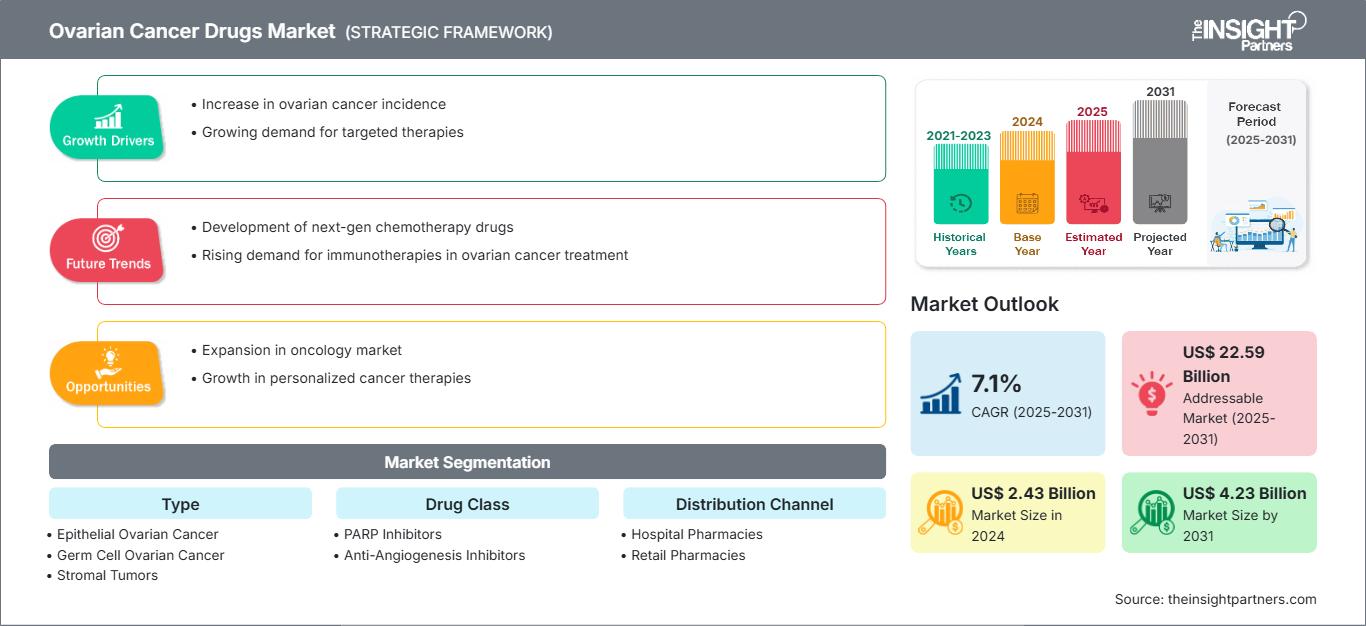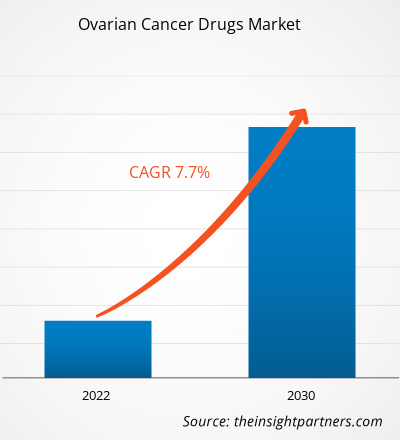Si prevede che il mercato dei farmaci per il cancro ovarico crescerà da 2,43 miliardi di dollari nel 2024 a 4,23 miliardi di dollari entro il 2031; si stima che il mercato registrerà un CAGR del 7,1% nel periodo 2025-2031.
Approfondimenti di mercato e opinioni degli analisti:
La crescente incidenza del cancro ovarico stimola la crescita del mercato dei farmaci per il cancro ovarico. Tuttavia, i richiami di prodotto dovuti a effetti avversi ostacolano la crescita del mercato.
Fattori di crescita:
La crescente incidenza del cancro ovarico stimola la domanda di opzioni terapeutiche
Il cancro ovarico è il settimo tumore più comune tra le donne e il terzo tumore ginecologico più comune, dopo rispettivamente il cancro cervicale e il cancro endometriale (uterino). Secondo il rapporto della World Ovarian Cancer Coalition, 324.000 donne ricevono una diagnosi di cancro ovarico e 207.000 donne muoiono a causa della malattia ogni anno. Inoltre, la maggior parte delle pazienti con cancro ovarico riceve una diagnosi di una condizione in stadio avanzato (localmente avanzato o metastatico), poiché non esiste un programma di screening sanitario pubblico per la diagnosi precoce del cancro ovarico. Pertanto, la crescente incidenza del cancro ovarico stimola la domanda di opzioni terapeutiche efficaci. La terapia di prima linea con una combinazione di chirurgia citoriduttiva e chemioterapia a base di platino è la terapia standard per le donne con nuova diagnosi di carcinoma ovarico avanzato. Inoltre, opzioni terapeutiche come gli inibitori di PARP approvati, olaparib, rucaparib e niraparib, rappresentano opzioni innovative per la gestione del carcinoma ovarico di nuova diagnosi. L'uso degli inibitori di PARP nella gestione del carcinoma ovarico avanzato si è inoltre rivelato un'opzione terapeutica efficace per migliorare i risultati clinici. Questi inibitori offrono efficacia a lungo termine e sopravvivenza libera da progressione (PFS) nei casi di nuova diagnosi, dopo una risposta completa (CR) alla prima, seconda e terza chemioterapia a base di platino.
Personalizza questo rapporto in base alle tue esigenze
Potrai personalizzare gratuitamente qualsiasi rapporto, comprese parti di questo rapporto, o analisi a livello di paese, pacchetto dati Excel, oltre a usufruire di grandi offerte e sconti per start-up e università
Mercato dei farmaci per il cancro ovarico: Approfondimenti strategici

-
Ottieni le principali tendenze chiave del mercato di questo rapporto.Questo campione GRATUITO includerà l'analisi dei dati, che vanno dalle tendenze di mercato alle stime e alle previsioni.
Segmentazione e ambito del rapporto:
L'analisi del mercato dei farmaci per il cancro ovarico è stata condotta considerando i seguenti segmenti: tipologia, classe di farmaci e canale di distribuzione.
Analisi segmentale:
Per tipologia, il mercato è segmentato in carcinoma ovarico epiteliale, carcinoma ovarico a cellule germinali e tumori stromali. Il segmento del carcinoma ovarico epiteliale ha detenuto la maggiore quota di mercato dei farmaci per il cancro ovarico nel 2022; si prevede che lo stesso segmento registrerà il CAGR più elevato, pari all'8,2%, durante il periodo di previsione. Secondo il rapporto di Cancer Research UK, il carcinoma ovarico epiteliale è il tipo più comune di carcinoma ovarico. Ad esempio, quasi 90 tumori ovarici su 100 (90%) sono tumori epiteliali. Le pazienti con carcinoma ovarico aggressivo in fase avanzata hanno a disposizione opzioni terapeutiche limitate sul mercato. Nel novembre 2022, la Food and Drug Administration (FDA) ha annunciato l'approvazione per "mirvetuximab soravtansine-gynx", prodotto da Elahere ImmunoGen, Inc., per pazienti adulte affette da carcinoma ovarico epiteliale. La dose raccomandata dai medici per questo farmaco candidato per il trattamento del carcinoma ovarico epiteliale è di 6 mg/kg, somministrata una volta ogni tre settimane tramite infusione endovenosa. Nel gennaio 2024, la FDA ha annunciato l'approvazione per la designazione fast-track (FTD) per "RC88", un coniugato anticorpo-farmaco (ADC) mirato alla mesotelina per il trattamento di pazienti con carcinoma ovarico epiteliale recidivante. Pertanto, il crescente numero di approvazioni di farmaci sta alimentando il mercato dei farmaci per il cancro ovarico nel segmento del cancro ovarico epiteliale.
Tendenze del mercato dei farmaci per il cancro ovarico
Terapia farmacologica combinata
Diversi istituti di ricerca medica stanno sviluppando nuovi farmaci combinati per il trattamento dei tumori ovarici. Nel settembre 2023, i ricercatori del Royal Marsden hanno annunciato una nuova terapia farmacologica combinata che si è dimostrata efficace nelle pazienti affette da cancro ovarico avanzato. I ricercatori hanno testato la terapia farmacologica combinata per il suo effetto sul cancro ovarico sieroso di basso grado (LGSOC), una rara forma di cancro ovarico con uno scarso tasso di risposta ai trattamenti. Lo studio clinico RAMP-201 è stato condotto combinando il farmaco avutometinib con defactinib per studiarne l'effetto terapeutico sinergico nelle pazienti affette da LGSOC. I risultati provvisori dello studio clinico rivelano che il 45% delle pazienti trattate con la combinazione di farmaci ha visto una significativa riduzione del tumore. Risultati clinici così soddisfacenti con la terapia combinata sono quasi due volte più efficaci rispetto al trametinib, un farmaco per terapia mirata disponibile in Inghilterra con un tasso di risposta di appena il 26%. Nel gennaio 2024, la FDA ha annunciato l'approvazione per il farmaco combinato SH-105 per il trattamento di pazienti con carcinoma mammario e ovarico. Pertanto, le terapie farmacologiche combinate stanno emergendo come nuove tendenze che probabilmente stimoleranno la crescita del mercato dei farmaci per il carcinoma ovarico nei prossimi anni.
Analisi regionale:
L'ambito del rapporto sul mercato dei farmaci per il carcinoma ovarico comprende Nord America, Europa, Asia-Pacifico, America meridionale e centrale, Medio Oriente e Africa. Nel 2022, il Nord America deteneva la maggiore quota di mercato dei farmaci per il carcinoma ovarico. La crescita del mercato in questa regione è trainata dal crescente numero di lanci di prodotti da parte delle principali aziende e dalla presenza di attori chiave del mercato. Gli Stati Uniti sono il principale contributore al mercato in Nord America. L'aumento dell'incidenza del tumore ovarico tra le donne spinge le aziende e gli enti regolatori a sviluppare e approvare farmaci innovativi in questa regione. Inoltre, il crescente numero di organizzazioni di ricerca clinica a contratto (CRO) favorisce la crescita del mercato dei farmaci per il tumore ovarico in Nord America.
Approfondimenti regionali sul mercato dei farmaci per il cancro ovarico
Le tendenze regionali e i fattori che influenzano il mercato dei farmaci per il cancro ovarico durante il periodo di previsione sono stati ampiamente spiegati dagli analisti di The Insight Partners. Questa sezione illustra anche i segmenti e la geografia del mercato dei farmaci per il cancro ovarico in Nord America, Europa, Asia-Pacifico, Medio Oriente e Africa, America meridionale e centrale.
Ambito del rapporto di mercato sui farmaci per il cancro ovarico
Densità degli operatori del mercato dei farmaci per il cancro ovarico: comprendere il suo impatto sulle dinamiche aziendali
Il mercato dei farmaci per il cancro ovarico è in rapida crescita, trainato dalla crescente domanda da parte degli utenti finali, dovuta a fattori quali l'evoluzione delle preferenze dei consumatori, i progressi tecnologici e una maggiore consapevolezza dei benefici del prodotto. Con l'aumento della domanda, le aziende stanno ampliando la propria offerta, innovando per soddisfare le esigenze dei consumatori e sfruttando le tendenze emergenti, alimentando ulteriormente la crescita del mercato.

- Ottieni il Mercato dei farmaci per il cancro ovarico Panoramica dei principali attori chiave
Sviluppi del settore e opportunità future:
Le previsioni di mercato dei farmaci per il cancro ovarico possono aiutare gli stakeholder di questo mercato a pianificare le proprie strategie di crescita. Di seguito sono elencati alcuni sviluppi strategici dei principali attori che operano nel mercato:
- A novembre 2022, ImmunoGen ha ottenuto l'approvazione della FDA per ELAHERE (mirvetuximab soravtansine-gynx) per il trattamento di pazienti adulte resistenti al cancro ovarico epiteliale platino-resistente. ELAHERE è specificamente approvato per le pazienti con carcinoma ovarico FR&-positivo resistente al platino, una condizione complessa a causa della disponibilità di opzioni terapeutiche limitate e degli scarsi risultati clinici delle terapie esistenti.
Panorama competitivo e aziende chiave:
Elli Lilly, AstraZeneca, GSK, Zielab, ImmunoGen (AbbVie), GeneTech (Roche), Vivesto, Allarity Therapeutics, Inc., Aeterna Zentaris e Luye Pharma sono tra le aziende di spicco descritte nel rapporto di mercato sui farmaci per il carcinoma ovarico. Queste aziende si concentrano sullo sviluppo di nuove tecnologie, sull'aggiornamento dei prodotti esistenti e sull'espansione della loro presenza geografica per soddisfare la crescente domanda dei consumatori in tutto il mondo.
- Analisi storica (2 anni), anno base, previsione (7 anni) con CAGR
- Analisi PEST e SWOT
- Valore/volume delle dimensioni del mercato - Globale, Regionale, Nazionale
- Industria e panorama competitivo
- Set di dati Excel
Report recenti
Rapporti correlati
Testimonianze
Motivo dell'acquisto
- Processo decisionale informato
- Comprensione delle dinamiche di mercato
- Analisi competitiva
- Analisi dei clienti
- Previsioni di mercato
- Mitigazione del rischio
- Pianificazione strategica
- Giustificazione degli investimenti
- Identificazione dei mercati emergenti
- Miglioramento delle strategie di marketing
- Aumento dell'efficienza operativa
- Allineamento alle tendenze normative






















 Ottieni un campione gratuito per - Mercato dei farmaci per il cancro ovarico
Ottieni un campione gratuito per - Mercato dei farmaci per il cancro ovarico